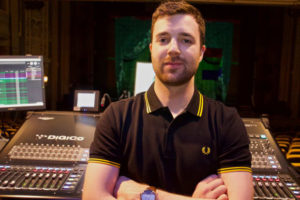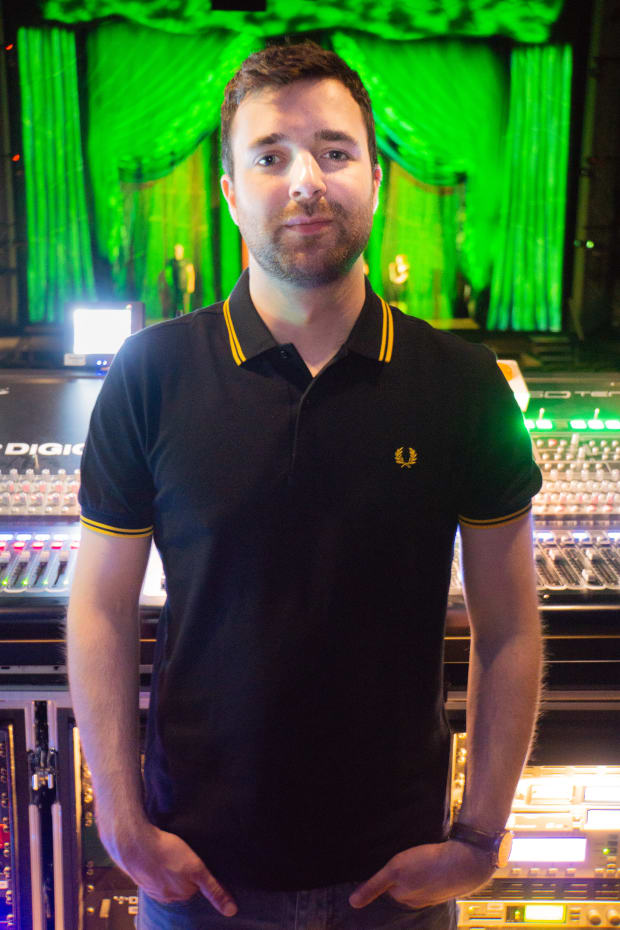
Shrek The Musical head of sound Eamon Walsh on a career in theatre audio
Over the past 10 years, theatre sound engineer Eamon Walsh has been building a rather impressive CV, having worked on numerous high-profile productions in various capacities up and down the country
Since taking his first job in pro audio as a sound engineer with Apex Acoustics Sound Services back in 2006, Eamon Walsh has been steadily building a reputation as one of the UK’s leading talents in the world of theatrical audio.
Having immersed himself in the world of sound from the age of just 16 when he took on a work experience placement with a sound hire company, he has seen his career gather pace at a rate of knots.
Here, Walsh tells PSNEurope editor Daniel Gumble about his favourite gear, some of the biggest projects he’s worked on to date and the most challenging aspects of pursuing a career in theatrical sound…
What first appealed to you about a career in audio engineering?
I have been interested in sound engineering from a young age, even before I really knew what it was! I come from a musical family and as a child used to go to shows and concerts quite often. I was always intrigued by the guy standing at the back in front of what looked like a spaceship. I had no idea what it did but it fascinated me. While I was at secondary school I contacted a sound hire company to ask about the possibility of doing a work experience placement there. The director of the company agreed and I had a very enjoyable and memorable week there. I continued my placement over the next few weeks, tagging along and helping out where I could at different shows and concerts. I was only 16 at the time but decided this was a great way into the industry. I left school that summer and continued working and gaining experience with the company while doing a college course in sound production. I became a full-time employee a year later and stayed for a further three years before pursuing a freelance career in sound.
How did you get into the theatrical side of the industry?
The hire firm I first worked for was predominately a theatre sound company. They did their fair share of concerts and other projects too but specialised in theatre. When I first started there I was quite open-minded to all aspects of the industry, but after seeing what went into mixing a musical I was fairly certain that was the route I wanted to pursue. There is something about the pressure of mixing a musical that I really enjoy. You have a lot of people to please, from the sound designers to the director and the musical supervisor, and it can certainly be quite a stressful environment at times. But the sense of accomplishment after mixing a good show, especially on an opening night, makes all the long hours worthwhile.
What project are you currently working on?
I am currently head of sound on Shrek The Musical, which is touring the UK and Ireland. It’s a great show to mix with a lot going on at times, so it certainly keeps you on your toes. One of the challenges of this show is mic positioning. A large amount of the cast are wearing masks and hats that cover half of their face, which makes our job a bit tricky. But with some clever positioning and EQ, as well as a great team backstage keeping them in check, we are able to work around them. Also, cleaning green paint out of mics is a never-ending task!
What are the key pieces of equipment you are using on the show?
We are using a Digico SD10T with remote engine at FOH and band monitoring is all done on an Aviom system. We have around 32 channels of radio mics and are using the new Shure Axient Digital system with ADX1M transmitters. We have been really impressed with this system. They sound great and keep the cast happy with the packs being nice and compact. There is a touring sound team of three who are all trained to mix the show. This means we are fully covered with at least two people in the theatre at all times who can mix the show. Which is a good job, as Shrek is touring for around 13 months.
What are the key differences between FOH engineering with a touring band and mixing for a musical like Shrek?
In theatre, generally speaking, we tend to play to audiences of up to around 3,000. Obviously, the numbers can be much higher when touring with a band. In theatre, we need to have the capability of bringing the sound levels right back to underscore level without the sound image disappearing completely into to the pit. And then, within the same number, be able to push the system to a loud but controlled sound. This is achieved by keeping acoustic noise levels to a minimum, by keeping drums and percussion in booths and, where possible, taking all amps out of the pit. This isn’t the case for all musicals but is certainly the blueprint for a lot of them. Without this, often in small theatres it can become a bit loud and messy before it even reaches the PA. I would say theatre and touring bands are striving for the same final product, which is the best possible sounding production within their various limitations. Both fields are mixing a live band with live vocals but with different mixing practises and different expectations.
Is the process of finding work as a freelance theatrical sound engineer the same as for a touring engineer?
There are a few different ways you can end up working on a show. If you work with the same sound designer quite a lot, then they will often approach you about shows they have coming up. If there is a show I really want to work on, I will often contact the sound designer to express my interest.
To keep things fair, a lot of shows now will require you to apply for the position. But ultimately it’s up to the sound designer who will be head of sound. And in most cases the head of sound will then have a say in who is employed in the rest of the department. In general, this industry relies a lot on word-of-mouth. I have got a lot of work this way and also found some great people to work with through picking up the phone.
Talk us through some of the biggest projects you’ve worked on.
One of the biggest and most unusual productions I’ve worked on was a show by Punchdrunk called The Drowned Man. This wasn’t a conventional show in a theatre with a seated audience. It was a large promenade performance over five floors at the old Royal Mail sorting office in Paddington. The audience was free to wander wherever they liked, following different performers to get their own version of the show. The clever lighting and extremely detailed set was incredible, it really felt like you were entering a different world. The scale of this show was huge. You could go and see the show 10 times and see it from a completely different perspective every time.
The sound design played a big part in the production, with constant sound throughout the whole show on timed loops so performers knew where they had to be and when. It was a massive install job for sound with every inch of the building needing covering, while being as invisible as possible. The show ran on timecode with numerous Qlab machines, also syncing up with lighting.
Another show with big production values was The Pyjama Game, which ran at the Shaftesbury Theatre in London and was directed by Sir Richard Eyre. The show was very slick and had an amazing orchestra and talented cast. It wasn’t for everyone and the storyline was a little old fashioned, but the quality of contribution from every department made it one of my favourite shows to mix every night.
What are the biggest challenges you face as a theatrical sound engineer?
In theatre, we often memorise scripts so we know exactly which line is coming next and when to fire sound effects etc. We do this for a number of reasons.
Firstly, it’s much easier to listen when you’re not reading. But mainly, as we predominately use omnidirectional microphones on the cast, as much as possible we only have a mic live if that person is talking or singing, known as line crunching. We do this mostly to stop microphones phasing and also to reduce the amount of excess noise and gain in the system. This is probably one of the biggest challenges of mixing a musical. It takes quite a high level of concentration and if you let your mind wander for a few seconds at the wrong point, you can easily miss lines and find yourself in the wrong desk scene and even firing the wrong sound effect. We also can’t get into too much of a rhythm, as no two shows are the same. We need to be constantly reacting to what is happening in the present, not what happened yesterday.
Another challenge we face is touring sound. We work closely with the production sound engineers who move the show and set up the PA system, so as much as possible our faders are sitting in the right place. But the acoustic difference between theatres can be huge. Trying to maintain the sound design of the show from theatre to theatre is one of the biggest and most enjoyable challenges of touring.
What’s the most demanding project you have worked on so far?
Every show comes with its own set of challenges, whether it’s controlling and balancing a large orchestra with an ensemble or mixing a smaller musical or play with only a few mics but hundreds of sound cues.
One of the most recent challenges I’ve encountered was touring the last version of Sister Act: The Musical. As well as a core band that played offstage, we had a lot of players with radio mics on their instruments playing onstage. This threw up quite a few obstacles like being able to properly mix the onstage players in with the core band without it sounding like two different shows.
Also, trying to avoid trumpets and saxophones etc. playing directly into the mics of those singing as much as possible. The cast of performers and musicians were extremely talented and very accommodating to our requests, and worked with us to achieve what was a great sounding production.

What are your most essential pieces of kit?
There are lots of great products around just now. I have been using Kv2 speakers quite a lot over the last few years and have been very impressed. The detail and clarity in the system is excellent, and not just a few meters away but all the way at the back of the room, making it a pleasure to mix on. I am currently using a Meyer Sound system and, of course, I have no complaints. I’ve used Meyer for years and they’re an industry leader for a reason. But when it comes to a point source system, I think Kv2 have nailed it.
Something I think we all take for granted a little is Qlab. This has completely transformed the way in which we can very quickly edit sound effects amongst other things. We currently use Qlab on Shrek for sound effects, firing desk scenes and click tracks. It’s a tool that has hugely benefited the theatre industry and is a personal favourite of mine.
Want more stories like this sent straight to your inbox? Subscribe to our free daily newsletter here.
Source: mi-pro.co.uk




